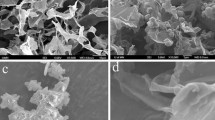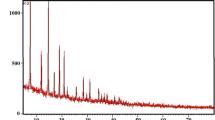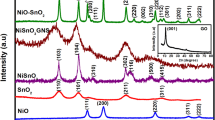Abstract
In this study, a nanocube of zeolitic imidazolate framework-67 (ZIF-67) was prepared by blending cobalt nitrate hexahydrate and 2-methylimidazole together in aqueous solutions containing hexadecyltrimethylammonium bromide (CTAB). Then, grapheme oxide (GO) wrapped ZIF-67 nanocomposites (ZIF-67/GO-n) were prepared by one-pot stirring method at room temperature. The morphology and microstructure of ZIF-67 and its GO nanocomposites were investigated by Raman spectra, X-ray diffraction (XRD), scanning electron microscopy (SEM), and Brunauer-Emmett-Teller (BET) specific surface area analysis. Electrochemical capacitance properties of all samples were characterized by cyclic voltammetry and chronopotentiometry, respectively. The results demonstrated that the content of GO used during synthesis process affected the specific capacity of nanocomposites while they were constructed as supercapacitor electrode. Compared with pure GO and ZIF-67 nanocubes, ZIF-67/GO-n composites had better specific capacitance. While the concentration of GO was 2 wt% based on their initial total mass of two reactants, ZIF-67/GO-2 composite presents a specific capacitance of 100.41 F g−1 at a sweep rate of 5 mV s−1. The good electrochemical performance of ZIF-67/GO-n composite may be credited to large BET surface area of ZIF-67 nanocubes and good conductivity of GO, and thus is expected to become a potential electrode material for supercapacitors.








Similar content being viewed by others

References
Wang YG, Song YF, Xia YY (2016) Electrochemical capacitors: mechanism, materials, systems, characterization and applications. Chem Soc Rev 45(21):5925–5950
Lv ZJ, Zhong Q, Bu YF (2018) In-situ conversion of rGO/Ni2P composite from GO/Ni-MOF precursor with enhanced electrochemical property. Appl Surface Sci 439:413–419
Suominen M, Lehtimäki S, Yewale R, Damlin P, Tuukkanen S, Kvarnstrӧm C (2017) Electropolymerized polyazulene as active material in flexible supercapacitors. J Power Sources 356:181–190
Jafari EA, Moradi M, Borhani S, Bigdeli H, Hajati S (2018) Fabrication of hybrid supercapacitor based on rod-like HKUST-1@polyaniline as cathode and reduced graphene oxide as anode. Phys E Low-dimensional Sys Nanostructures 99:16–23
Raj CJ, Rajesh M, Manikandan R, Sim JY, Yu KH, Park SY, Song JH, Kim BC (2017) Two-dimensional planar supercapacitor based on zinc oxide/manganese oxide core/shell nano-architecture. Electrochim Acta 247:949–957
Madhuvilakku R, Alagar S, Mariyappan R, Piraman S (2017) Green one-pot synthesis of flowers-like Fe3O4/rGO hybrid nanocomposites for effective electrochemical detection of Riboflavin and low-cost supercapacitor applications. Sens Actuators B Chem 253:879–892
Htut KZ, Kim M, Lee E, Lee G, Baeck SH, Shim SE (2017) Biodegradable polymermodified graphene/polyaniline electrodes for supercapacitors. Synth Met 227:61–70
Hosseini MG, Shahryari E (2017) Fabrication of novel solid-state supercapacitor using a Nafion polymer membrane with graphene oxide/multiwalled carbon nanotube/polyaniline. J Solid State Electrochem 21(10):2833–2848
Zhao Y, Song ZX, Li X, Sun Q, Cheng NC, Lawes S, Sun XL (2016) Metal organic frameworks for energy storage and conversion. Energy Storage Mater 2:35–62
Zhou YJ, Mao M, Wang W, Yang ZK, Liu X (2016) In-Situ fabrication of graphene oxide hybrid Ni-based metal−organic framework (Ni−MOFs@GO) with ultrahigh capacitance as electrochemical pseudocapacitor materials. ACS Appl Mater Interfaces 8(42):28904–28916
Wang L, Han YZ, Feng X, Zhou JW, Qi PF, Wang B (2016) Metal–organic frameworks for energy storage: batteries and supercapacitors, coordination. Chem Rev 307:361–381
Qu C, Jiao Y, Zhao BT, Chen DC, Zou RQ, Walton KS, Liu ML (2016) Nickel-based pillared MOFs for high-performance supercapacitors: design, synthesis and stability study. Nano Energy 26:66–73
Yu M, Lin D, Feng H, Zeng Y, Tong Y, Lu X (2017) Boosting the energy density of carbon‐based aqueous supercapacitors by optimizing the surface charge. Angew Chem Int Ed 56(20):5454–5459
Zeng Y, Lin Z, Meng Y, Wang Y, Yu M, Lu X, Tong Y (2016) Flexible ultrafast aqueous rechargeable Ni||Bi battery based on highly durable single-crystalline bismuth nanostructured anode. Adv Mater 28(41):9188–9195
Wang G, Zhang L, Zhang J (2012) A review of electrode materials for electrochemical supercapacitors. Chem Soc Rev 41(2):797–828
Gao T, Zhou F, Ma W, Li HB (2018) Metal-organic-framework derived carbon polyhedron and carbon nanotube hybrids as electrode for electrochemical supercapacitor and capacitive deionization. Electrochim Acta 263:85–93
Haldorai Y, Choec SR, Huh YS, Han YK (2018) Metal-organic framework derived nanoporous carbon/Co3O4 composite electrode as a sensing platform for the determination of glucose and high-performance supercapacitor. Carbon 127:366–373
Slater MD, Kim D, Lee E, Johnson CS (2013) Sodium-ion batteries. Adv Funct Mater 23(8):947–958
Kayal S, Sun B, Chakraborty A (2015) Study of metal-organic framework MIL-101(Cr) for natural gas (methane) storage and compare with other MOFs (metal-organic frameworks). Energy 91:772–781
Huang YB, Liang J, Wang XS, Cao R (2017) Multifunctional metal-organic framework catalysts: synergistic catalysis and tandem reactions. Chem Soc Rev 46(1):126–157
Zheng H, Zhang Y, Liu L, Wan W, Guo P, Nyström AM, Zou XD (2016) One-pot Synthesis of metal-organic frameworks with encapsulated target molecules and their applications for controlled drug delivery. J Am Chem Soc 138(3):962–968
Choi KM, Jeong HM, Park JH, Zhang YB, Kang JK, Yaghi OM (2014) Supercapacitors of nanocrystalline metal-organic frameworks. ACS Nano 8(7):7451–7457
Guo SN, Zhu Y, Yan YY, Min YL, Fan JC, Xu QJ, Yun H (2016) (Metal-Organic Framework)-Polyaniline sandwich structure composites as novel hybrid electrode materials for high-performance supercapacitor. J Power Sources 316:176–182
Hong JY, Jung YJ, Park DW, Chung S, Kim S (2018) Synthesis and electrochemical analysis of electrode prepared from zeolitic imidazolate framework (ZIF)-67/graphene composite for lithium sulfur cells. Electrochim Acta 259:1021–1029
Yang L, McNichols BW, Davidson M, Schweitzer B, Gómez-Gualdrón DA, Trewyn BG, Sellinger A, Carreon MA (2017) Noble metal-free catalytic decarboxylation of oleic acid to n-heptadecane on nickel-based metal–organic frameworks (MOFs). Catal Sci Technol 7(14):3027–3035
Kang L, Sun SX, Kong LB, Lang JW, Luo YC (2014) Investigating metal-organic framework as a new pseudo-capacitive material for supercapacitors. Chin Chem Lett 25(6):957–961
Wang P, Li CY, Wang WG, Wang J, Zhu YS, Wu YP (2018) Hollow Co9S8 from metal organic framework supported on rGO as electrode material for highly stable supercapacitors. Chin Chem Lett 29(4):612–615
Hummers WS Jr, Offeman RE (1958) Preparation of graphitic oxide. J Am Chem Soc 80(6):1339–1339
Hu H, Guan BY, Lou XW(D) (2016) Construction of complex CoS hollow structures with enhanced electrochemical properties for hybrid supercapacitors. Chem 1(1):102–113
Borhani S, Moradi M, Kiani MA, Hajati S, Toth J (2017) CoxZn1−x ZIF-derived binary Co3O4/ZnO wrapped by 3D reduced graphene oxide for asymmetric supercapacitor: comparison of pure and heat-treated bimetallic MOF. Ceram Int 43(16):14413–14425
Hu B, Qin X, Asiri AM, Alamry KA, Youbi Al AO, Sun X (2013) Fabrication of Ni(OH)2 nanoflakes array on Ni foam as a binder-free electrode material for high performance supercapacitors. Electrochim Acta 107:339–342
Zhang C, Mahmood N, Yin H, Liu F, Hou Y (2013) Synthesis of phosphorus-doped graphene and its multifunctional applications for oxygen reduction reaction and Lithium ion batteries. Adv Mater 25(35):4932–4937
Kudin KN, Ozbas B, Schniepp HC, Prud’homme RK, Aksay IA, Car R (2008) Raman spectra of graphite oxide and functionalized graphene sheets. Nano Lett 8(1):36–41
Silva De KKH, Huang HH, Joshi RK, Yoshimura M (2017) Chemical reduction of graphene oxide using green reductants. Carbon 119:190–199
Channei D, Nakaruk A, Phanichphant S (2017) Influence of graphene oxide on photocatalytic enhancement of cerium dioxide. Mater Lett 209:43–47
Krishnamoorthy K, Veerapandian M, Yun K, Kim SJ (2013) The chemical and structural analysis of graphene oxide with different degrees of oxidation. Carbon 53:38–49
Pan YC, Heryadi D, Zhou F, Zhao L, Lestari G, Su HB, Lai ZP (2011) Tuning the crystal morphology and size of zeolitic imidazolate framework-8 in aqueous solution by surfactants. CrystEngComm 13(23):6937–6940
Xu B, Yue SF, Sui ZY, Zhang XT, Hou SS, Cao GP, Yang YS (2011) What is the choice for supercapacitors: graphene or graphene oxide? Energy Environ Sci 4(8):2826–2830
Zhang X, Zhang DC, Chen Y, Sun XZ, Ma YW (2012) Electrochemical reduction of graphene oxide films: preparation,characterization and their electrochemical properties. Chin Sci Bull 57(23):3045–3050
Aboutalebi SH, Chidembo AT, Salari M, Konstantinov K, Wexler D, Liu HK, Dou SX (2011)Comparison of GO, GO/MWCNTs composite and MWCNTs as potential electrode materials for supercapacitors. Energy Environ Sci 4(5):1855–1865
El-Kady MF, Strong V, Dubin S, Kaner RB (2012) Laser scribing of high-performance and flexible graphene-based electrochemical capacitors. Science 335(6074):1326–1330
Zhang D, Shi H, Zhang R, Zhang Z, Wang N, Li J, Yuan B, Bai H, Zhang J (2015) Quick synthesis of zeolitic imidazolate framework microflowers with enhanced supercapacitor and electrocatalytic performances. RSC Adv 5(72):58772–58776
Meng W, Wen YY, Dai L, He ZX, Wang L (2018) A novel electrochemical sensor for glucose detection based on Ag@ZIF-67 nanocomposite. Sens Actuators B Chem 260:852–860
Kotz R, Carlen M (2000) Principles and applications of electrochemical capacitors. Electrochim Acta 452:2483–2498
Gao Y, Wu J, Zhang W, Tan Y, Gao J, Tang B, Zhao J (2014) Synthesis of nickel carbonate hydroxide/zeolitic imidazolate framework-8 as a supercapacitors electrode. RSC Adv 4(68):36366–36371
Diring S, Furukawa S, Takashima Y, Tsuruoka T, Kitagawa S (2010) Controlled multiscale synthesis of porous coordination polymer in nano/micro regimes. Chem Mater 22(16):4531–4538
Gross AF, Sherman E, Vajo JJ (2012) Aqueous room temperature synthesis of cobalt and zinc sodalite zeolitic imidizolate frameworks. Dalton Trans 41(18):5458–5460
Srimuk P, Luanwuthi S, Krittayavathananon A, Sawangphruk M (2015) Solid-type supercapacitor of reduced graphene oxide-metal organic framework composite coated on carbon fiber paper. Electrochim Acta 157:69–77
Funding
This work was financially supported by the Open Foundation of Key Laboratory of Optoelectronic Chemical Materials and Devices of Ministry of Education (No.JDGD-2016008), the Open Foundation of Hubei Key Laboratory of Industrial Fume & Dust Pollution Control (No.HBIK2016-01) and the National Training Programs of Innovation and Entrepreneurship for undergraduates (No.2017zd041).
Author information
Authors and Affiliations
Corresponding author
Rights and permissions
About this article
Cite this article
Cao, W., Han, M., Qin, L. et al. Synthesis of zeolitic imidazolate framework-67 nanocube wrapped by graphene oxide and its application for supercapacitors. J Solid State Electrochem 23, 325–334 (2019). https://doi.org/10.1007/s10008-018-4138-1
Received:
Revised:
Accepted:
Published:
Issue Date:
DOI: https://doi.org/10.1007/s10008-018-4138-1



